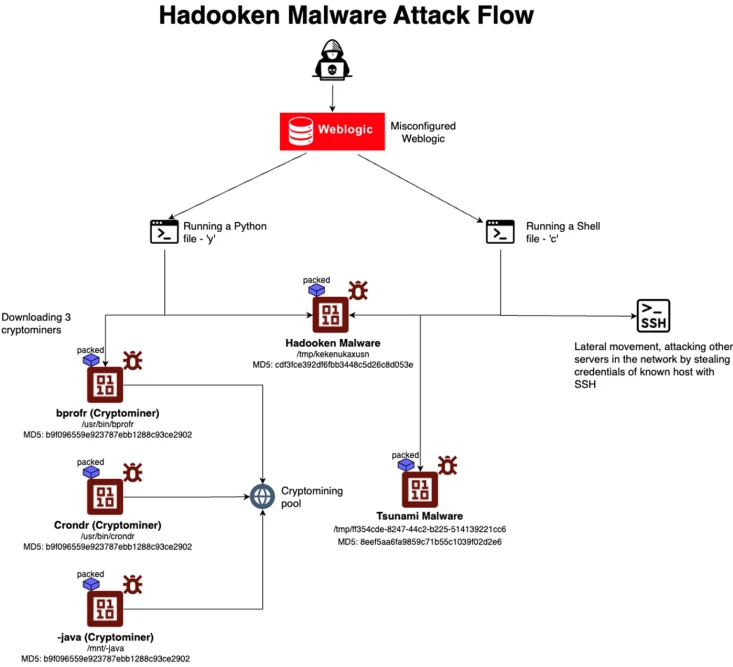Fighting Back Against Hadooken Malware by Strengthening WebLogic Security

Cybercriminals have been relentlessly attacking the digital landscape, aiming to exploit vulnerabilities in well-known systems. One such exploit is the recently discovered Hadooken malware, which targets Oracle WebLogic applications.
To help you secure your server against this emerging threat, we will explore the intricacies of the Hadooken malware, understand its operational mechanics, and pinpoint the targets it aims to compromise. We'll then offer practical detection and mitigation advice for Linux administrators and organizations.
An Introduction to Oracle WebLogic Server
Oracle WebLogic Server is a leading enterprise-level Java EE application server widely utilized for building, deploying, and managing large-scale, distributed applications. Developed by Oracle, it boasts strong support for Java technologies, transaction management, and scalability. Due to its prevalence in critical sectors such as banking, e-commerce, and various business-critical systems, WebLogic is often a prime target for cyberattacks.
Despite its robust architecture, WebLogic has been susceptible to attacks due to vulnerabilities such as deserialization flaws and improper access controls. Misconfigurations, like weak credentials or exposed admin consoles, can lead to severe consequences, including remote code execution (RCE), privilege escalation, and data breaches if not properly secured or patched.
How Does Hadooken Malware Operate?
Hadooken malware is a complex threat that targets WebLogic servers by exploiting weak credentials and other vulnerabilities. When executed, the malware introduces additional threats, including the Tsunami malware and a crypto-miner. Here's a breakdown of the Hadooken malware's operation:
 Source: AquaSec Blog
Source: AquaSec Blog
Initial Access and Execution
The attackers gain initial access by exploiting weak credentials on WebLogic servers. Once inside, they achieve remote code execution. The malicious script downloads two scripts, a shell script named ‘c’ and a Python script named ‘y’, which serve as secondary payload mechanisms.
Payload Delivery
The primary payload, Hadooken malware, gets downloaded into non-persistent temporary directories. The Python script iterates over several paths to secure the download and execution while subsequently deleting the original file to avoid detection.
The shell script similarly downloads the Hadooken malware into the /tmp directory, executing and then deleting it to remain stealthy.
Secondary Malware
Hadooken executes to deploy both a crypto-miner and Tsunami malware. Once packed and unpacked, the crypto-miner is dropped into several paths: /usr/bin/crondr, /usr/bin/bprofr, and `/mnt/-java. The Tsunami malware is also deployed, randomly named, into the /tmp/<<random>> directory, although indications show it isn't immediately used in the attack.
Persistence and Evasion
Hadooken creates multiple cron jobs to maintain persistence, using random names and varying frequencies for execution scripts under different cron directories. The malware employs tactics to evade detection by renaming its crypto miner to familiar names like -bash and deleting logs after execution.
Lateral Movement and Impact
Hadooken attempts to iteratively access SSH keys, allowing it to move laterally across connected servers within an organization.
The malware's impact is evident in its resource hijacking for crypto-mining and its potential to introduce ransomware such as RHOMBUS and NoEscape in prolonged campaigns.
Detection and Mitigation: Best Practices for Linux Admins and Organizations
 Given the sophisticated nature of Hadooken malware and the severity of its impact, Linux administrators and organizations must adopt a comprehensive approach to detect, mitigate, and prevent such threats. Here are some actionable strategies to secure your server and your Linux environment against Hadooken malware:
Given the sophisticated nature of Hadooken malware and the severity of its impact, Linux administrators and organizations must adopt a comprehensive approach to detect, mitigate, and prevent such threats. Here are some actionable strategies to secure your server and your Linux environment against Hadooken malware:
- Infrastructure as Code (IaC) Scanning: Scan IaC templates such as Terraform, CloudFormation, or Kubernetes YAML files for potential misconfigurations before deployment.
- Cloud Security Posture Management (CSPM): Continuously scan cloud configurations for misconfigurations, compliance violations, and security risks across services like AWS, Azure, and GCP.
- Kubernetes Security and Configuration: Regularly scan Kubernetes clusters for compliance with security best practices. Ensure alignment with CIS Kubernetes benchmarks.
- Container Security: Perform thorough vulnerability scanning of container images and Docker files to identify and rectify misconfigurations and vulnerabilities.
- Runtime Security Monitoring: Implement runtime security tools to monitor cloud-native applications for anomalies and suspicious behaviors in real time.
Our Final Thoughts on Protecting Against Hadooken Malware
The Hadooken malware illustrates the evolving nature of cyber threats targeting enterprise-level applications like Oracle WebLogic. Linux administrators and organizations can significantly mitigate risk and safeguard critical systems by understanding its operation and adopting proactive and reactive security measures. Continuous vigilance, regular updates, strong authentication practices, and comprehensive security tools are paramount in maintaining a secure digital environment amidst these growing threats.













